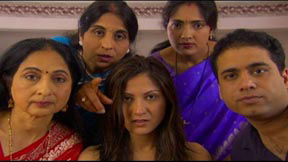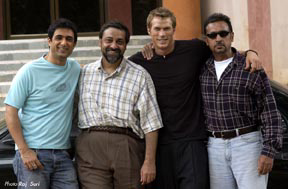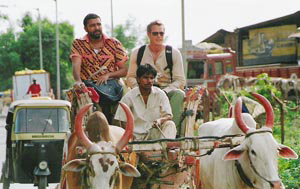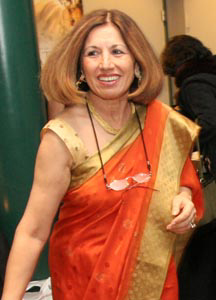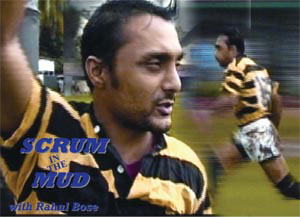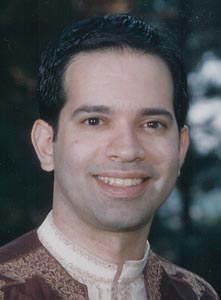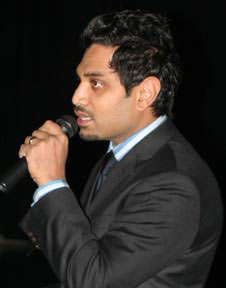Arts
Have Film, Need Money

Indian American filmmakers are scrounging for finance
Ruchi Narain grew up in Muscat and Dubai. Fifteen years ago, at the age of 20 she left to settle down in India and pursue a career in cinema. When she went to make her first movie, Kal, she turned not to banks or family for the funding, but to her contacts in the Middle East. Narain, who has been an associate director and co-writer on Sudhir Mishra’s Hazron Khwahishen Aisi, set up on her debut venture with a complete business plan in hand. She sold shares in her film to about 20 investors, raising $500,000. Her movie, now released in India, has already recovered the investment and has been shown at several film festivals. The overseas sales and DVD sales are to come. She has already got the financing for her next movie, and is making it exactly the way she envisaged it.
A Cinderella story, if ever there was one because most filmmakers’ journeys Cinema may be all about make-believe, but one thing about it is no fantasy: the hard as nails reality of raising money to make something as ephemeral as films. It’s may be about creativity, but it rides on a money trail, and young Indian American filmmakers, some veterans of a few movies, others still in film school are realizing this harsh truth. And even if you manage to get your movie made, how do you go about marketing and distributing it? All of it requires a lot of green stuff. So unless you have a sugar daddy or a very, very rich uncle, you’re out of luck! On the one side are established filmmakers like M.Night Shyamalan, Mira Nair, Deepa Mehta, Shekhar Kapur and Gurinder Chadha who are name brands by now and command big budgets from major studios. The late Ismail Merchant was a master at raising funds and the awards and critical acclaim for Merchant Ivory films ensured that the money was always there for whichever projects – often literary adaptations – Merchant and James Ivory chose to undertake. Ashok Amritraj, based in Hollywood, is also a filmmaker whose formidable contacts have ensured steady financing.
But what about the countless young emerging filmmakers across the United States? Many of them are just fresh out of film school and have neither the name recognition nor a track record. So how do these neophytes raise the money and handle the marketing and distribution of their films? “Most films produced by South Asians in the United States are funded privately through friends and family who invest money. Filmmakers in the United States do not have the benefit of getting substantial government help to finance films the way their Canadian and British counterparts do,” says Gitesh Pandya, editor of BoxOffice Guru.
Filmmakers are discovering it is necessary to go global. Funding can be raised anywhere – in London, Delhi or New York. Increasingly Indian Americans are going back and forth. There has been a lot of jetting. Filmmakers like Nagesh Kukonoor from Atlanta and Apoorva Lakhia from New York re now settled in India, making movies in Mumbai with local investors. Aroon Shivdasani, director of the Indo-American Arts Council (IAAC), has been hosting an annual film festival with films from the diaspora and has seen her share of young filmmakers since her festival is a nurturing ground for new and emerging talents. She points out that there are many levels of filmmakers in the Diaspora – ranging from the noted names to the first time or emerging filmmakers who form the bulk of Diaspora filmmakers.
“Every one of them chases every possible resource to raise money for their films,” she says. “I am sure all of them have some sort of business plan, whether it pans out as first presented is another matter and depends on how well known they are, how much experience they have, how good their marketing strategy is, or whether they know a wealthy investor. Many of them produce films for school, on a shoe-string budget, on loans, with help from family and friends.” Nikhil Kamkolkar, of Kamkol Production in North Brunswick, N.J., the creator of Indian Cowboy has shown the film at several film festivals and has now found a distributor for the movie. How did he fund the film? He laughs, “It was all F and F – friends and family funding.” For the postproduction costs, he looked for investors at The Indus Entrepreneurs: “We had a company showcase, we presented the film, an investors kit and met with investors. A lot of the desi investors were interested, but they were involved with technology investing as opposed to film investing so a lot of education had to be done.”
TIE is an enabling organization that exposes entrepreneurs to the investors: “It’s not as simple as you ask for money and you receive a check; it’s very much about educating them.” He’s now working on a film noir thriller, and this time it’s going to be very different, he says, because he’s understood the pattern of the industry and is now looking at private investors. In marketing the film, the strategy was to show it at several film festivals to get mainstream recognition in order to get distribution. Indian Cowboy is being distributed in limited markets by UTV and says Kamkolkar, “It’s being handled by people who are in the business and we hope to work together again in the future. It’s all about building relationships.” Priti Chowdhury is a young Chicago-based physician who has just made her first movie Finding Preet and has fully financed it from her physician’s income. No wonder parents are always badgering their children to become doctors!
This young pediatric anesthesiologist also runs a chic Mediterranean restaurant called La Mora, which too may has helped in income generation. Finding Preet, which premiered at the IAAC Festival in New York, is almost autobiographical, following the adventures or Priti Malani, a 34 year old Indian American physician and restaurant owner, searching for preet or love. The film, with a cast and crew of 35, was shot in about a month, using real life locales such as her hospital and her own restaurant, which were all built into the story. She also used herself and her family in the movie and she says about her parents, “Who better to play them?” Finding Preet has shown at two mainstream film festivals in California and received a warm response from audiences. Chowdhury is working on several scripts, one being a medical suspense mystery. She also plans a book, a pilot for a TV show, and definitely another film, but this time she’ll look for outside investment.
According to Shilen Amin, the director of the South Asian International Film Festival (SAIFF), first time filmmakers often tap siblings, parents, uncles and aunts and friends for finances, but, he says, this can really strain relationships. Other filmmakers sell business shares so that the film ultimately becomes a company, an enterprise. He says, “Your brand as an individual is also worth something. Piyush Pandya, for instance, has a track record with American Desi so it’s easier for investors to believe in him.” He says there are multiple variations in the funding game since there are so many physicians and entrepreneurs who have so much money and want to get into the glamour world, since their every day life is far removed from the glitz of the entertainment world. An amount like $10-50,000, even $100,000 dollars is a drop in the bucket for some of them, and to have their names associated with cinema has cachet, but he points out that they are not going to blindly unload their wallets, although some do. Many young filmmakers, who have graduated from prestigious film schools are getting involved in short films. Samir Patel, of Reformer Films, New Jersey, is the filmmaker of a short Time and the Hour Run, a lyrical story of loss and alienation in an isolated desi-owned motel in the American wilderness. Patel, who’s in multimedia consulting, says: “I paid for it myself. What I’ve been doing is I’ll make films for the majority of the year and for a few months do some contract work to make my money, so to speak, and then use that to make more films.”
How does he plan to distribute and market the film? “Since it’s a short film I’m really just looking to get into festivals. It’s just a resume for me to show people what I’ve done,” he says. “But I’d like to make a feature film and am writing the script and will shop it around. For that I will be looking for investors. I won’t be funding that myself.” However, he knows that finances from investors is a double-edged sword, and often comes with strings attached. He says, “I even had relatives offering to give me money that I turned down only because I didn’t want to deal with certain expectations they have of what the film would be. They wanted a Bollywood romantic musical and I want to make a film on my own terms, without having to worry about any of that. So while it’s very stressful to spend your money, but you have complete freedom over what you do.” Simone Ahuja of Blood Orange Media, Minneapolis, Minn., is another young filmmaker who’s using her primary profession to fund her passion for cinema. “What I attempt to do is fund most projects on my own through my dental practice simply because it’s so challenging to seek funding,” she says. “I find if I’m doing a smaller project sometimes it’s so mentally exhausting to go through the creative process, the pre-production, the post-production, the marketing, distribution, everything. I’m now getting into larger projects. I’m seeking private investors and working with channels.”
She adds, “But I’m also acting as my own distributor. It eats up a whole lot of creative time when I’d rather be making films, but distributors take up to 35 percent.” Her short film Scrum in the Mud, starring Rahul Bose has been marketed through festivals and has sold to television networks. She says, ” The audiences can be small but now there are channels that are interested.” One has to admire the enthusiasm of these young filmmakers. Rahul Das, 27, has made two shorts The Intruder and India Spiceland, which have played at festivals in Toronto, Seattle, Los Angeles, and New York. He says, “Raising money for my independent films, that too shorts, is pretty tough, regardless of the fact that I have been in this medium for some time now. “While going to a very competitive grad film school full time, I was also working as a teaching assistant, bartender, a resident assistant, reporter, and in a variety of other jobs to finance these films. When it’s your own hard earned money you are spending, you tend to be more determined that you are going to give your 100 percent to this film and make it the best you can.”
He says his passion invariably rubs off on others and he’s received funding from his school, CalArts, organizations like Kodak, and Panavision, and a grant from the Taraknath Das Foundation. He is now working on the script for his first feature and will soon have the funding to contend with. One piece of good news for emerging filmmakers is the increasing democratization of media and accessibility created by digital media. “Advances in technology and decreases in cost have made filmmaking more feasible in every way, significantly decreasing financial barriers,” Ahuja says. “By the same token, there are now more outlets than ever for filmmakers to show their work – broadband and VOD – with revenue share models that are quickly becoming an option that can help filmmakers to keep their heads above water and help them think about making their next film.”
Add to that IT professionals, who sometimes bring a more serious business plan to the table. When Vivek Wadhwa, founder of Relativity Technologies, in Raleigh, N.C., decided to take the plunge with a film called My Bollywood Bride, he already had a game plan. He says, “I actually treated it like a business venture, and studied the market opportunity, positioning and sales strategies. I structured a deal like a tech venture, where instead of stock, we “We defined three rounds of financing with different ‘valuations’ and returns commensurate with the risk. And I had a top lawyer draw up contracts that were very tight. We also created requirements for the producer to produce audited financials, and provided a structure that penalized him for cost overruns. I brought my technology management and marketing skills to the table.” How difficult was it to raise funds and did he tap into his Silicon Valley connections? He says, “It was very difficult. Most people don’t trust the film industry. Many in Silicon Valley have invested with small time filmmakers from India and the U.S. in the past and have lost their investment. Even big Bollywood names that raised money here ended up ripping investors off. That is the hurdle we faced and most filmmakers face. The only way I was able to get my friends to invest was by investing my own money first and by taking an executive producer role.”
The film, which stars Hollywood hunk Jason Lewis from Sex and the City, had a initial budget of $1 million, but this has swelled to $2.5 million, after investors saw the interest that was generated by the film and the marketing possibilities. Currently Wadhwa says his company has one of the top sales agents in Hollywood and is being marketed by IAC Films. For most emerging film-makers in the United States, getting the investment is the hardest part of film-making. Their peers have it easier in the UK and Canada, where there is some state funding for local filmmakers and support in marketing their films. Says Wadhwa, “It is good to get government assistance, but this amounts to hardly 15 percent of the budget. What makes or breaks the film is its quality and market opportunity. Too many filmmakers don’t understand what market they are going after. For example too many produce films for the NRI market in the U.S. without realizing that this market is too small to support the production of a quality film. Hence they all lose their investments.”
For many new filmmakers, film festivals catering to South Asian films, which have sprouted up in several cities, are a real lifesaver. These are the nurturing grounds, the networking zones and often the places to find financiers and distributors. Besides the IAAC and SAIFF Festivals in New York, there is also the IFFLA in Los Angeles and the Indian Film Festival in Toronto. Just this year Harish Saluja is shaping up a new festival “Silk Screen” in Pittsburgh to showcase the films of new and established filmmakers from Asia and America. The festivals invite major distributors to see the films and occasionally some filmmakers hit gold.
“I feel it’s a twofold process. First, educate and second, bring in the people who are already interested in cinema and are interested in buying it or distributing it or presenting it. There is a lot to be done in the future,” says Shilen Amin of SAIFF. He believes by networking and advertising the festival in mainstream film publications there will be more exposure for the films, which will attract a crossover audience. In the end, it’s all a game of numbers, of what financiers “There is a need to have a production company that is well funded that could finance multiple feature films each year,” says Gitesh Pandya. “There is a tremendous amount of talent in the South Asian community and a large consumer base for these films. The first company that can finance a bridge between the two and truly bankroll multiple films in this space will be very successful and become the dominant player in this market for years to come.” |


